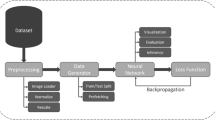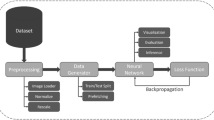Abstract
Segmentation of brain aneurysm is of paramount importance in aneurysm treatment planning. However, the segmentation of intensity varying and low-contrast cerebral blood vessels is an extremely challenging task. In this paper, we present an approach to segmenting the brain vasculature in low contrast computed tomography angiography and magnetic resonance angiography. The main contributions are: (1) a stochastic resonance based methodology in discrete Hartley transform domain is developed to enhance the contrast of a selected angiographic image for patch placement, and (2) a multi-scale adaptive principal component analysis based method is proposed that estimates the phase map of input images. Level-set method is applied to the phase-map data in order to segment the vasculature. We have tested the algorithm on real datasets obtained from two sources, CIBC institute and Hamad Medical corporation. The average Dice coefficient (in %) is found to be \(94.1\pm 1.2\) (value indicates the mean and standard deviation) whereas average false positive ratio, false negative ratio, and specificity are found to be 0.019, \(7.55\times 10^{-3}\), and 0.75, respectively. Average Hausdorff distance between segmented contour and ground truth is determined to be 2.97 mm. The qualitative and quantitative results show promising segmentation accuracy reflecting the potential of the proposed method.









Similar content being viewed by others
References
Andersson, T., Lathen, G., Lenz, R., & Borga, M. (2013). Modified gradient search for level set based image segmentation. IEEE Transactions on Image Processing, 22(2), 621–630.
Assa, A., & Janabi-Sharifi, F. (2015). A Kalman filter-based framework for enhanced sensor fusion. IEEE Sensors Journal, 15(6), 3281–3292.
Auer, M., & Gasser, T. C. (2010). Reconstruction and finite element mesh generation of abdominal aortic aneurysms from computerized tomography angiography data with minimal user interactions. IEEE Transactions on Medical Imaging, 29(4), 1022–1028.
Bogunovic, H., Pozo, J., & Villa-Uriol, M. (2011). Automated segmentation of cerebral vasculature with aneurysms in 3DRA and TOF-MRA using geodesic active regions: An evaluation study. Medical Physics, 39(1), 210–222.
Bracewell, R. M. (1983). The discrete Hartley transform. Journal of the Optical Society of America, 73(12), 1832–1835.
Bracewell, R. M. (1986). The Fourier Transform and its application (2d ed.). New York: McGraw-Hill.
Chandrasekhar, S. (1943). Stochastic problems in physics and astronomy. Reviews of Modern Physics, 15, 1–89.
Chan, T., & Vese, L. (2001). Active contours without edges. IEEE Transactions on Image Processing, 10(2), 266–277.
Chouhan, R., Kumar, P., Kumar, R., & Jha, R. (2011). Contrast enhancement of dark images using dynamic stochastic resonance in wavelet domain. Proceedings of IMLC, 3, 191–196.
Chou, Kenneth C., Willsky, Alan S., & Ramine, N. (1994). Multiscale systems Kalman filters and Riccati equations. IEEE Transactions on Automatic Control, 39, 479–492.
Chowriappa, A., Seo, Y., Salunke, S., Mokin, M., Kan, P., & Scott, P. (2014). 3D vascular skeleton extraction and decomposition. IEEE Journal of Biomedical and Health Informatics, 18(1), 139–147.
Costa, P. J. F., Alonso, H., & Roque, L. (2011). A weighted principal component analysis and its application to gene expression data. IEEE/ACM Transactions on Computational Biology and Bioinformatics, 8(1), 246–252.
Dakua, S. P. (2011). Performance divergence with data discrepancy: A review. Artificial Intelligence Review, 40, 429–555.
Data available: http://www.sci.utah.edu/cibc-software/cibc-datasets.html.
Egan, J. (1975). Signal detection theory and ROC analysis. New York: Academic Press.
Filho, M. E., Ma, Z., & Tavares, J. M. R. S. (2015). A review of the quantification and classification of pigmented skin lesions: From dedicated to hand-held devices. Journal of Medical Systems, 39, 1–12.
Gammaitoni, L., Hanggi, P., Jung, P., & Marchesoni, F. (1998). Stochastic resonance. Reviews of Modern Physics, 70, 223–270.
Gard, T. (1998). Introduction to stochastic differential equations. New York: Marcel-Dekker.
Hernandez, M., & Frangi, A. (2007). Non-parametric geodesic active regions: Method and evaluation for cerebral aneurysms segmentation in 3DRA and CTA. Medical Image Analysis, 11(3), 224–241.
Jiang, J., & Strother, C. M. (2013). Interactive decomposition and mapping of saccular cerebral aneurysms using harmonic functions: Its first application with patient-specific computational fluid dynamics (CFD) simulations. IEEE Transactions on Medical Imaging, 32(2), 153–164.
Jodas, D. S., Pereira, A. S., & Tavares, J. M. R. S. (2016). A review of computational methods applied for identification and quantification of atherosclerotic plaques in images. Expert Systems with Applications, 46, 1–14.
Kang, D., Suh, D. C., & Ra, J. B. (2009). Three-dimensional blood vessel quantification via centerline deformation. IEEE Transactions on Medical Imaging, 28(3), 400–407.
Kwak, N. (2008). Principal component analysis based on L1-norm maximization. IEEE Transactions on Pattern Analysis and Machine Intelligence, 30, 1672–1680.
Law, M. W. K., & Chung, A. C. S. (2013). Segmentation of intracranial vessels and aneurysms in phase contrast magnetic resonance angiography using multirange filters and local variances. IEEE Transactions on Image Processing, 22(3), 845–859.
Lazar, I., & Hajdu, A. (2013). Retinal micro-aneurysm detection through local rotating cross-section profile analysis. IEEE Transactions on Medical Imaging, 32(2), 400–407.
Li, C., Huang, R., Ding, Z., Gatenby, J. C., Metaxas, D. N., & Gore, J. C. (2011). A level set method for image segmentation in the presence of intensity inhomogeneities with application to MRI. IEEE Transactions on Image Processing, 20(7), 2007–2016.
Ma, Z., Tavares, J. M. R. S., & Jorge R. M. N. (2009). A review on the current segmentation algorithms for medical images. In Proceedings of first international conference on imaging theory and applications (IMAGAPP), Portugal (pp. 135–140). ISBN: 978-989-8111-68-5.
Ma, Z., Jorge, R. M. N., Mascarenhas, T., & Tavares, J. M. R. S. (2011). Novel approach to segment the inner and outer boundaries of the bladder wall in T2-weighted magnetic resonance images. Annals of Biomedical Engineering, 39(8), 2287–2297.
Ma, Z., Jorge, R. M. N., Mascarenhas, T., & Tavares, J. M. R. S. (2013). Segmentation of female pelvic organs in axial magnetic resonance images using coupled geometric deformable models. Computers in Biology and Medicine, 43(4), 248–258.
Manniesing, R., Velthuis, B. K., van Leeuwen, M. S., Van Der Schaaf, I. C., van Laar, P. J., & Niessen, W. J. (2006). Level set based cerebral vasculature segmentation and diameter quantification in CT angiography. Medical Image Analysis, 10(2), 200–214.
Ma, Z., Tavares, J. M. R. S., Jorge, R. M. N., & Mascarenhas, T. (2010). A review of algorithms for medical image segmentation and their applications to the female pelvic cavity. Computer Methods in Biomechanics and Biomedical Engineering, 13(2), 235–246.
Mukherjee, J., & Mitra, S. K. (2008). Enhancement of color images by scaling the DCT coefficients. IEEE Transactions on Image Processing, 17, 1783–1794.
Oliveira, R. B., Filho, M. E., Ma, Z., Papa, J. P., Pereira, A. S., & Tavares, J. M. R. S. (2016). Computational methods for the image segmentation of pigmented skin lesions: A review. Computer Methods and Programs in Biomedicine, 131, 127–141.
Piccinelli, M., Veneziani, A., Steinman, D. A., Remuzzi, A., & Antiga, L. (2009). A framework for geometric analysis of vascular structures: Application to cerebral aneurysms. IEEE Transactions on Medical Imaging, 28(8), 1141–1155.
Radaelli, A. G., & Peiro, J. (2010). On the segmentation of vascular geometries from medical images. International Journal for Numerical Methods in Biomedical Engineering, 26(1), 3–34.
Rallabandi, V., & Roy, P. (2010). MRI enhancement using stochastic resonance in Fourier domain. Magnetic Resonance Imaging, 28, 1361–1373.
Santos, A. M. F., Tavares, J. M. R. S., Sousa, L. C., Santos, R. M., Castro, P., & Azevedo, E. (2013). Automatic segmentation of the lumen of the carotid artery in ultrasound B-mode images. In Proceedings of SPIE Medical Imaging 2013, Florida, USA.
Santos, A. M. F., Santos, R. M., Castro, P. M. A. C., Azevedo, E., Sousa, L., & Tavares, J. M. R. S. (2013). A novel automatic algorithm for the segmentation of the lumen of the carotid artery in ultrasound B-mode images. Expert Systems with Applications, 16, 6570–6579.
Shang, Y., Deklerck, R., Nyssen, E., Markova, A., Mey, J. D., Xin, Y., et al. (2011). Vascular active contour for vessel tree segmentation. IEEE Transactions on Biomedical Imaging, 58, 1023–1032.
Sousa, L. C., Castro, C. F., Antonio, C. C., Santos, A. M. F., Santos, R. M., Azevedo, E., et al. (2014). Toward hemodynamic diagnosis of carotid artery stenosis based on ultrasound image data and computational modeling. Medical and Biological Engineering and Computing, 51(11), 971–983.
Sousa, L. C., Castro, C. F., Antonio, C. C., Santos, A. M. F., Santos, R. M., Castro, P., et al. (2014). Haemodynamic conditions of patient-specific carotid bifurcation based on ultrasound imaging. Computer Methods in Biomechanics and Biomedical Engineering: Imaging and Visualization, 2(3), 157–166.
Villablanca, J. P., Duckwiler, G. R., Jahan, R., Tateshima, S., Martin, N. A., Frazee, J., et al. (2013). Natural history of asymptotic unruptured cerebral aneurysms evaluated at CT angiography. Radiology, 269, 258–265.
Villasenor, J. D. (1993). Alternatives to the discrete cosine transform for irreversible tomographic image compression. IEEE Transactions on Medical Imaging, 12(2), 803–811.
Wilson, R., Clippingdale, S. C., & Bhalerao, A. H. (1990). Robust estimation of local orientations in images using a multi-resolution approach. In Proceedings of SPIE visual communications and image processing’90: Fifth in a Series (Vol. 1360).
Wu, X., Luboz, V., Krissian, K., Cotin, S., & Dawson, S. (2011). Segmentation and reconstruction of vascular structures for 3D real-time simulation. Medical Image Analysis, 15(1), 22–34.
Yan, P., & Kassim, A. A. (2006). Segmentation of volumetric MRA images by using capillary active contour. Medical Image Analysis, 10(3), 317–329.
Yipeng, S., Xiaoming, T., Yang, L., & Jianhua, L. (2015). Robust 2D principal component analysis: A structured sparsity regularized approach. IEEE Transactions on Image Processing, 24(8), 2515–2526.
Author information
Authors and Affiliations
Corresponding author
Rights and permissions
About this article
Cite this article
Dakua, S.P., Abinahed, J. & Al-Ansari, A. A PCA-based approach for brain aneurysm segmentation. Multidim Syst Sign Process 29, 257–277 (2018). https://doi.org/10.1007/s11045-016-0464-6
Received:
Revised:
Accepted:
Published:
Issue Date:
DOI: https://doi.org/10.1007/s11045-016-0464-6




